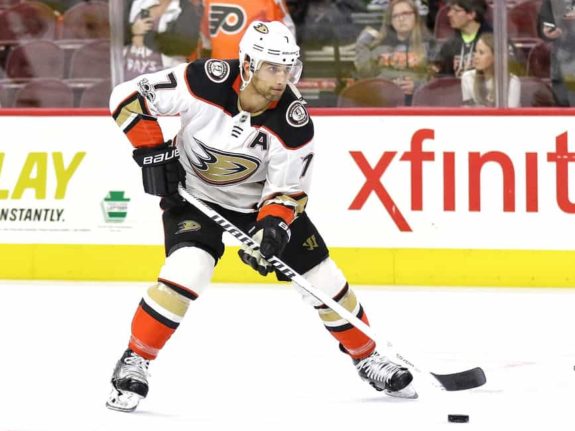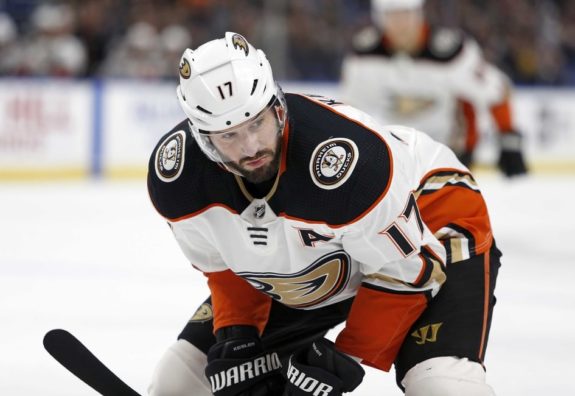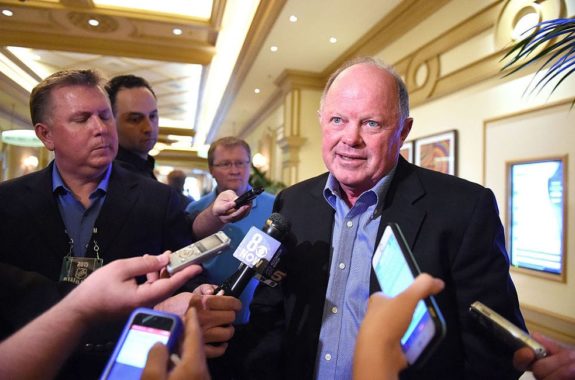It’s been a wild week so far in Anaheim Ducks country and amazingly, they’ve only played two games. The action has been more intense on the Ducks’ roster than on the ice. General manager Bob Murray has gone on a trading spree that has received mixed reaction among fans and media, the best of which came from Yahoo Sports’ Pete Blackburn.
Trying to figure out what exactly the Ducks are doing pic.twitter.com/lOhjTPn6iG
— Pete Blackburn (@PeteBlackburn) January 17, 2019
He’s not alone in his confusion for obvious reasons. Two of the players traded away were fan favorites, even though they’ve been quiet lately, while others were fringe players who have spent most of this season in the minors. Taken individually, these trades inspire little excitement, but as a whole, they are signs that the Ducks are ready to put more responsibility on their prospects.
Bob Murray’s Trade Fever
Take a deep breath if you’re reading these out loud, because it’s a lot to spit out. Since Monday, Murray has sent Andrew Cogliano to the Dallas Stars for Devin Shore, traded Pontus Aberg to the Minnesota Wild for Justin Kloos, shipped Joseph Blandisi to the Pittsburgh Penguins for Derek Grant and sent Luke Schenn and a seventh-round pick in 2020 to the Vancouver Canucks for Michael Del Zotto.
In addition, he called up promising rookies Troy Terry and Max Jones from the San Diego Gulls and sent Kiefer Sherwood and Jake Dotchin back down and that’s not everything. Murray also placeed Jakob Silfverberg and Ryan Kesler on injured reserve. These developments have made for an interesting week.
Devin Shore for Andrew Cogliano
As of Tuesday, this move looked like a “wake-up call” trade that didn’t make the Ducks any better. Cogliano’s departure is slightly confusing. His elite speed is seemingly what the Ducks needed to transition to a faster style. Instead, they traded him to the Stars. Dallas GM Jim Nill said of Cogliano, “We want to play a faster-paced game. And I think Andrew Cogliano’s one of the best at that in the league.” So how committed are the Ducks to playing that style?
Cogliano was also one of Anaheim’s key penalty killers, ranking second among forwards in shorthanded time-on-ice behind Kesler. Shore also sees a lot of time on the penalty kill and while it’s true Cogliano has had a disappointing offensive season, so has Shore. Cogliano had only three points in his last 13 games with the Ducks. Shore had three points in his last 17 games with Dallas, although he had an assist in his debut for the Ducks on Thursday when they finally broke their franchise-record 12-game losing streak.

Clearly, Murray hopes the younger Shore still has some unrealized offensive potential and enough speed that Cogliano’s performance won’t be missed. By itself, the trade in on-ice performance will not make a big difference in the Ducks’ fortunes for the rest of the season.
However, the trade did free up cap space that enabled the moves that followed. Cogliano’s contract lasts through the 2020-21 season and carries a $950,000 cheaper cap hit per season, but since the other trades were made, the Ducks cap space is back under $50,000.
Justin Kloos for Pontus Aberg
This trade feels like an inexpensive gamble. After the Ducks claimed him off waivers, Aberg potted 11 goals, good for second on the team when he was traded. Unfortunately, he hadn’t managed a point since mid-December and fell out of favor with Randy Carlyle. Carlyle moved him down to the fourth line and then scratched him in four straight games. According to Ducks beat writer Elliott Teaford, Carlyle said of Aberg,
“Looking for a competitive spirit, for somebody who’s going to get inside. We know he’s got a skill set and can score goals. To me, it’s more about him getting inside and being first on the forecheck when it’s his turn to be first. First on the backcheck. His overall compete has to go up. Too much on the perimeter.” (from ‘Ducks deal Pontus Aberg to Wild for prospect as roster makeover continues’ – The Orange County Register – 1/16/19)
And so, Aberg found himself on a plane to Minnesota to join his new team, playing his old team Thursday night. Neither he, nor his new teammates could solve John Gibson in the Wild’s 3-0 loss to the Ducks.
In return, the Ducks received Kloos, a 5-foot-9 forward with speed and penalty killing experience (in the minors), but with only one game of NHL service. If you take his AHL numbers, he looks like he has scoring potential. He set the Iowa Wild rookie scoring record when he had 50 points in 76 games in the 2017-18 season.
On the other hand, The Athletic’s prospects writer Corey Pronman listed him as depth piece saying,
“Kloos isn’t the most dynamic small guy, but he is talented, very quick, and works so hard each game. He can kill penalties at the pro level and create some offense.”(from ‘NHL farm system rankings: No. 18 Minnesota Wild’ – The Athletic NHL – 8/14/18)
That sounds like a rookie version of Cogliano, so maybe he’s Cogliano’s true replacement while Murray hopes Shore’s offensive output can replace Aberg’s. When it comes to contracts and salary, both Aberg and Kloos are restricted free agents after this season, so there’s no flexibility gained or lost there.
Derek Grant for Joseph Blandisi
Grant is a minor upgrade. The Penguins placed him on waivers earlier in the season and he’s been up and down between the AHL and NHL since. Blandisi had no points in three games for the Ducks whereas Grant had five points in 25 games this season for the Penguins before he returned to the Ducks. Grant had a career year with the Ducks last season, scoring 12 goals and adding 12 assists in 66 games.
In addition, Grant has shown a continued ability to win faceoffs during his career, including 57.1 percent at even strength this season. That alone provides some upside for the Ducks because they’ll have a bottom-six center who can win faceoffs which can help their putrid puck possession numbers.
Del Zotto for Luke Schenn and a 7th-Round Pick in 2020
This trade is a slight upgrade for Anaheim on the ice as well. Del Zotto hasn’t played in the AHL this season but he’s regularly been a healthy scratch for the Canucks. He only has four points through 23 games in 2018-19, but his puck-moving skills are much better than Schenn’s. Unfortunately for him, the Ducks’ defense corps is already full of skilled puck-moving defensemen so Del Zotto will likely fight for a spot on the third pairing.
Troy Terry and Max Jones Called Up
These are the most significant moves the Ducks have made since Monday. With injuries to Kesler and Silfverberg and the demotion of Sherwood, the Ducks called up Terry and Jones.

Terry is the co-leader in points for the Gulls with 37 while Jones is third with 24. Terry’s return and Jones’ debut have been much anticipated by fans and the Ducks hope they will bring the offensive energy that has been lacking during their losing streak.
Though they didn’t find the scoresheet Thursday night against the Wild, Terry showed improved composure with the puck and made several skilled passes and Jones held his own in his debut. Jones, the Ducks’ first-round pick from 2016, is big, fast and well-rounded with a rocket shot.
Though Terry and Jones are slotted to play wing and the newcomer Shore at center between the two of them, it’s hard to imagine any of them will struggle as much as Kesler did producing points for the Ducks. Before his injury, he managed one point in his last 31 games. That’s not the production you expect from a third-line center.
Flux for the Ducks
What is Murray trying to do? Some have said he’s shuffling the “fringes” of his lineup. In a Tweet, Helene Elliott of the Los Angeles Times had a similar opinion.
To recap: Ducks today reacquired Derek Grant, acquired Michael Del Zotto, acquired Justin Kloos. Talk about nibbling around the edges of a problem…
— Helene Elliott (@helenenothelen) January 17, 2019
That is what he’s doing, but he doesn’t have much of a choice. For the time being, he’s said he won’t make a coaching change, and the Ducks are still in contention for a playoff spot, so they aren’t in a position to be “sellers” right now.

Though he’d probably love to trade Kesler or Perry, it’s obvious nobody would take them, and as long as the playoffs are within reach, trading an attractive, top-line player would be foolish. They’re also trying to transition to a faster brand of hockey with younger players, so giving up prospects for an established difference-maker on offense would be shortsighted.
The key to these trades is the lack of commitment to these new players while also stirring the pot to motivate the team. None of the players acquired in trades, except for Shore, would be wasted if they were assigned to the AHL. That means Jones and Terry could remain with the Ducks when Silfverberg, Kesler and Patrick Eaves return, which is drawing closer.
It also gives the team the option to bring Sam Steel or Sherwood back up. Clearly Murray isn’t relying on his newly-acquired players to make the difference. He’s using them as placeholders, hoping his home-grown rookies will stick with the team and accelerate the Ducks’ transition to a younger, faster team.
All stats provided by Hockey-Reference and Natural Stat Trick.